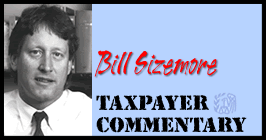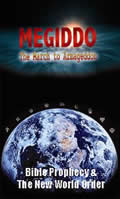Other
Sizemore Articles:
The 'Passion', Why so Much Blood?
Judges Who Break the Law - Judges Who Steal
They Don't Steal All Our Chickens
Blame The Oregon
Supreme Court For The P.E.R.S. Problem
'Vote By Mail' A
Formula For Fraud
When Your Signature Doesn't Count
The Curse Of regional Governments
By Bill Sizemore
July 3, 2004
NewsWithViews.com
My first experience with a jury trial was a real eye-opener. I had no idea of the extent to which judges sometimes make this basic, constitutional right a total farce.
The theory behind the right to a trial by jury is that before a citizen is deprived of liberty or property, the accused will be tried before a panel of his or her peers, who will hear the evidence from both sides and render a decision based upon the facts, as they perceive them.
In theory, the jury is the �fact finder� in the case. However, that is not always the way it works in real life. Sometimes, the judge manipulates the jury to insure that the conclusion it reaches is the one he desires.
However, if a judge can arbitrarily determine the outcome of a trial, simply by controlling what evidence a jury hears, a trial by a jury of one�s peers is a farce. After all, it is not really a trial by jury, if the jurors only hear what the judge lets them hear. It is still a trial by a single judge.
There are valid reasons why some �evidence� should be admissible and some not. Trials would go on forever, if both sides could present all the evidence they wanted, regardless of relevance. Someone has to decide whether evidence is relevant or prejudicial, but therein lies the rub. The one who decides what evidence the jury will hear, in reality has total control of the outcome, because a judge can manipulate a jury the same way an editor can manipulate public opinion, simply by editing the evidence and limiting what the hearer hears.
Let me give you an example of how this works, from personal experience. In 2002, Oregon Taxpayers United, an organization I once headed, was sued by two teachers unions, which claimed that they were forced to spend approximately a million dollars fighting two ballot measures. The unions claimed among other things that the measures were placed on the ballot by means of forgeries. (Actually, the public employee unions collectively spent more than $5 million fighting the two measures, but they thought they had a better chance of winning in court, if they had the �school teachers� sue us.)
In the course of the trial, the teachers union lawyers presented to the jury persuasive evidence of approximately a dozen to two dozen forgeries on petition sheets; all �collected� by one person. We never disputed that the signatures were forged. In fact, we stipulated before hand that they were. We simply claimed that we had no prior knowledge that the signatures had been forged and also that the unions could not have been harmed by this small handful of forgeries.
In our defense, when you collect hundreds of thousands of signatures in a short period of time, as we did, it is not unusual for a few forged signatures to slip through. In fact, it may be inevitable. Forging signatures is like counterfeiting money. It happens, and if the counterfeiter is good enough, it is extremely difficult to catch them.
Because the teachers unions were asking for all of their campaign money back, tripled, as damages, we needed to prove to the jury that one to two dozen forgeries simply could not have caused the unions harm or made them spend all that money.
Our case was not hard to make. We had solid, tangible evidence that the unions were not damaged by that handful of forged signatures. Our problem, however, was not a lack of proof. Our problem was, the judge would not let the jury see the proof.
You see, the same exact matter that was at issue in our case had surfaced regarding another measure in the same election. The same woman, who had forged the signatures on the measures over which the unions were suing us, also had forged about a dozen signatures on another measure.
In that case, after consulting with the attorney general, the secretary of state had issued a statewide press release, stating that he would not keep a measure off the ballot because of a handful of forgeries, if the sponsors had collected enough good signatures to qualify the measure for the ballot. He ordered that the other measure be placed on the ballot, in spite of the forgeries, because the sponsors had collected enough valid signatures.
In our case, we also had collected hundreds of thousands of good signatures; far more than were necessary to qualify for the ballot. The handful of forgeries clearly could not have forced the unions to spend millions campaigning against the measure, because the secretary of state had already declared to the entire state that he would place such measures on the ballot anyway. If you stop and think about it, what other conclusion could he have reached? Why disenfranchise a hundred thousand voters, who had legitimately signed a petition, because of a dozen inconsequential signatures forged by one person?
As I said above, our case really was an easy one to make. To win, all we had to do was show the jury the secretary�s of state press release, which had been quoted in every daily newspaper in the state and prominently featured on the nightly news, and the controversy would end.
Alas, that was not to be. The union lawyers objected to the press release on grounds of hearsay. Fair enough. There was a better source for that information than the secretary�s press release, i.e., the secretary himself.
We would simply subpoena the secretary of state, or someone from his office, to appear in court and answer one simple question: Would the elections division have placed these two measures on the ballot anyway, even if it was known beforehand there were a handful of forgeries?
All the Elections Division had to do was say, �Yes,� and the unions� claim would be dismissed. But once again, this was not to be.
The secretary of state, a regular recipient of union political donations, claimed that because he had issued the press release based on the advice of the attorney general, the press release was protected by attorney client privilege, and thus inadmissible in court.
How does one respond to such a self-interested dereliction of duty? How does one respond to a claim that a press release, which was published in newspapers across the state and shown on the nightly television news, was somehow confidentially protected by attorney client privilege? Nevertheless, that�s the position our secretary of state took.
In the end, the judge ruled that the jury would not be shown the press release and that the secretary of state would not be allowed to testify, because it would �only confuse the jury.�
He was right about that. That evidence indeed would have confused the jury. The jurors would have wondered what in blazes we were doing in court that day on such a ridiculous charge. They would have wondered how the unions possibly could think that they had been damaged by a mere dozen forgeries out of more than 260,000 signatures collected, if the secretary of state would have placed the measure on the ballot anyway.
Unfortunately, the jurors never saw or heard that evidence. All they saw was indisputable evidence that there were a handful of forgeries on our petition sheets, which made them anxious to punish someone for committing such a terrible crime.
In our case, the jury was manipulated by a liberal judge, who wanted the case to go the unions� way; a judge who throughout the trial shamelessly gave the unions lawyers every substantive thing they asked for. When push came to shove, he kept from the jury evidence that would have left them no choice, but to find in our favor.
I wonder just how many cases have been manipulated as ours was. I wonder how many times judges have withheld critical evidence from juries, due to personal bias. I wonder how many billions of dollars have changed hands due to such decisions, and how many years innocent people have spent behind bars.
In this country, the right to a trial by a jury of one�s peers is a sacred and indispensable right; guaranteeing that before a citizen is deprived of property or freedom, he can present his defense to a jury of his peers. Like so many other basic rights, however, this one is falling by the wayside, the victim of biased judges.
When a judge withholds critical evidence from a jury, it will not be lady justice, who has on the blindfold. It will be the jury itself, and the jury trial so conducted will be little more than a sham.
� 2004 Bill Sizemore - All Rights Reserved
Sign Up For Free E-Mail Alerts
E-Mails are used strictly for NWVs alerts, not for sale
Bill Sizemore is a registered Independent who
works as executive director of the Oregon Taxpayers Union, a statewide
taxpayer organization. Bill was the Republican candidate for governor
in 1998. He and his wife Cindy have four children, ages eight to thirteen,
and live on 36 acres in Beavercreek, just southeast of Oregon City, Oregon.
Bill Sizemore is considered one of the foremost experts on the initiative
process in the nation, having placed dozens of measures on the statewide
ballot. Bill was raised in the logging communities of the Olympic Peninsula
of Washington state, and moved to Portland in 1972. He is a graduate of
Portland Bible College, where he taught for two years. A regular contributing
writer to www.NewsWithViews.com.
E-Mail: bill@otu.org
Bill's Web site: www.Billsizemore.net
Sometimes, the judge manipulates the jury to insure that the conclusion it reaches is the one he desires.








